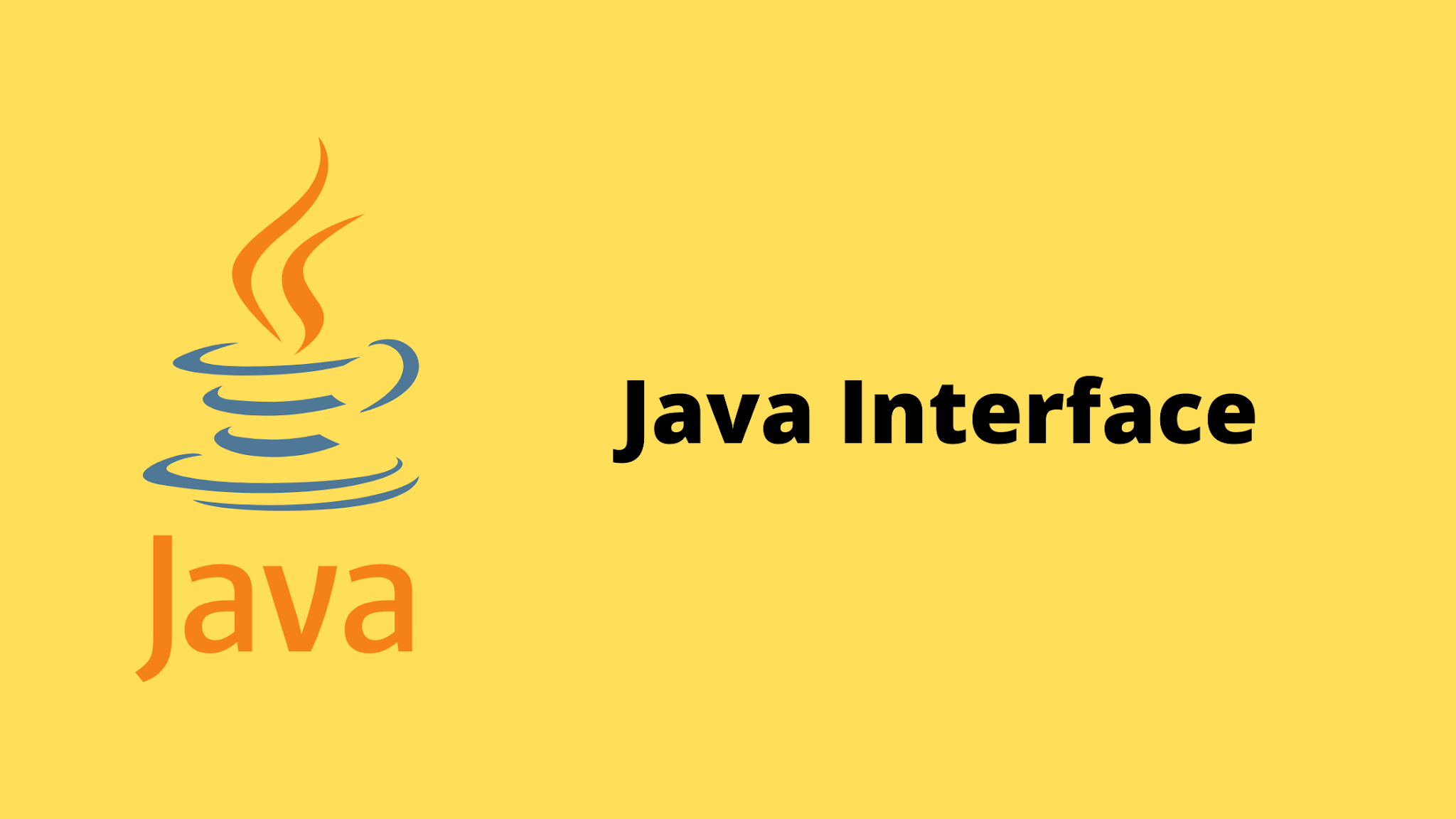 Logicmojo - Updated Dec 19, 2022
Logicmojo - Updated Dec 19, 2022
Introduction
Ever questioned how to use an interface in Java? The interface is the pinnacle of Java's Object-Oriented Programming. Code readability and project speed are enormously improved, and a completely new level of data abstraction is achieved. The Java Programming Language's Java Interface is an advanced level of abstraction. Java interface makes things easier to read and less complicated, which reduces code complexity.
Computer interface is referred to be a line dividing two or more systems. It transfers information—which could be signals, commands, or protocols—between system components.
Java Abstraction offers a method's functionality by concealing the implementation logic contained within the method. In a similar vein, the Java Interface is also an Abstract Class that only contains the method declaration. An interface is implemented by a class in order to inherit abstract methods. An interface may also have constants, static methods, nested interfaces, default methods, and abstract methods.
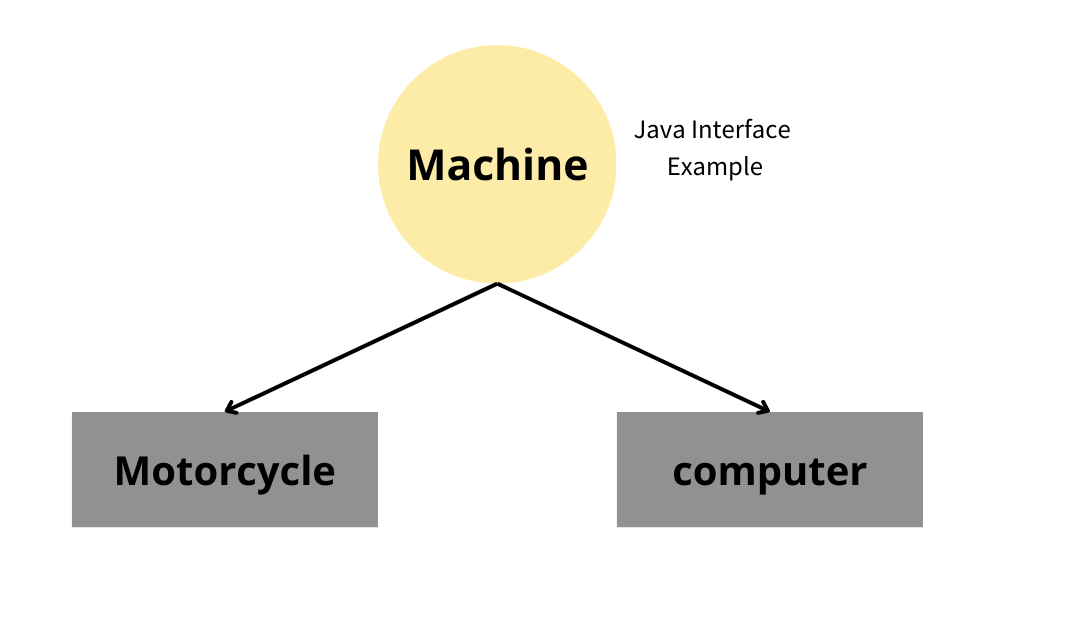
Need for Interface in Java
Communication: One of the functions of the interface is to facilitate communication. You can declare how the methods and fields of a given type should work through the interface.
Multiple Inheritance: Java does not provide multiple inheritance, however you can achieve multiple inheritance using interfaces.
Abstraction: Abstraction is the process of shielding the user from the implementation specifics in order to merely supply them with the functionality. To put it another way, the user will know what the object does rather than how it does it. Since all of the interface's methods are abstract, just the method signature and prototype are known to the user. You can achieve (full) abstraction via interfaces.
Coupling: The phrase coupling refers to how one class depends on another. Therefore, while using an interface, we define the method and signature independently. In this technique, Loose Coupling is archived and all methods and classes are completely independent.
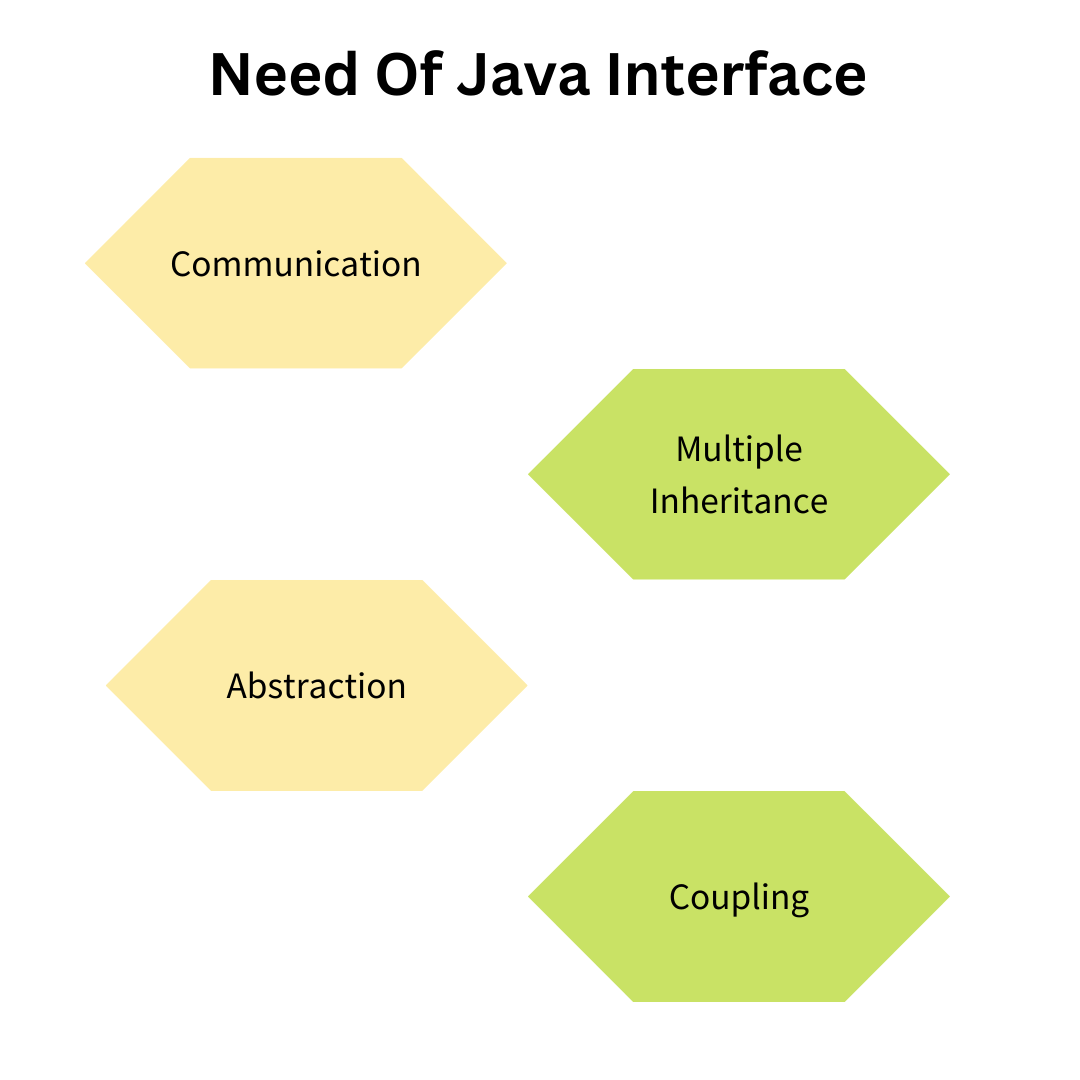
Syntax:
The interface keyword is used to declare an interface. An interface's public, static, and final properties are all set to their default values, and its methods all have an empty body. A class that implements the interface is required to implement each of its functions.
interface <interface_name>{
// declare constant fields
// declare methods that abstract
// by default.
}
Class and Interface Similarities
An interface can have as many methods as necessary, just like a class.
The interface is written in a file with a.java extension, just as classes.
Unexpectedly, an interface's bytecode will have surfaced in a.class file.
An interface is displayed as a package, and the corresponding bytecode is located in a directory with the same name as the package.
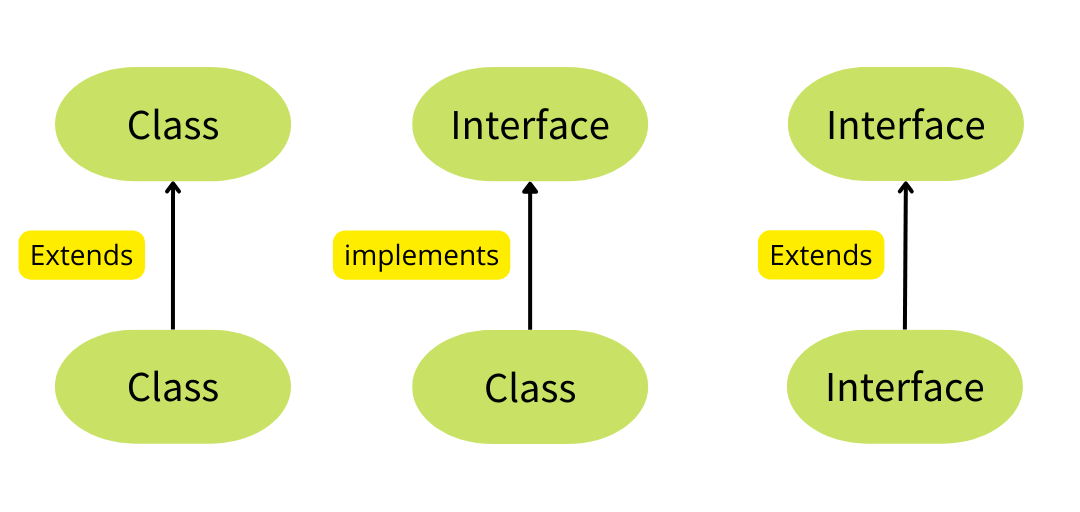
Class and Interface Differences
You can instantiate variables and make objects in a class. You cannot instantiate a variable and produce an object in an interface.
A class may include concrete methods that have implementation. The interface is not permitted to include concrete (implementation-ready) methods.
Classes employ the access specifiers private, protected, and public. Interface only uses the Public specifier.
Difference between abstract class and interface
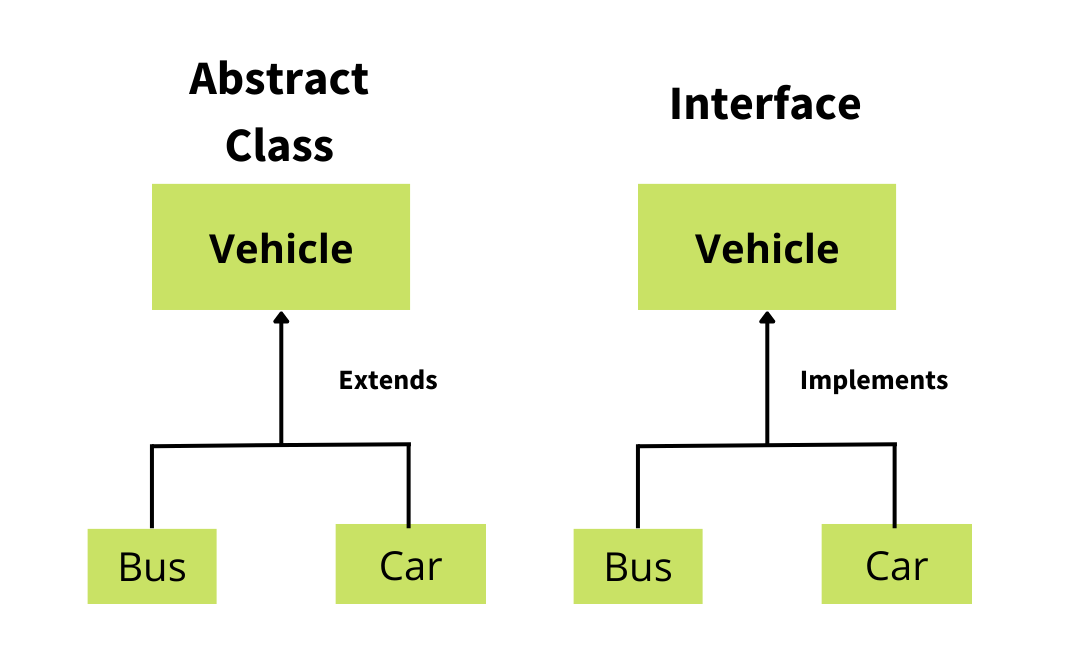
| Abstract class | Interface |
|---|---|
| Both abstract and concrete methods can be found in abstract classes. | There can only be abstract methods on an interface. Starting with Java 8, it is possible to have both default and static methods. |
| An interface can be implemented by abstract classes. | Interface can only extend another interface; it cannot implement another interface. |
| Any type of member, such as private or public, can be included in an abstract class. | All members of an interface must be public. |
Multiple inheritance Implementation in Java by interface
Several inheritance occurs when a class implements multiple interfaces or when an interface extends multiple interfaces.

interface Interface1{ public static int num = 100; public default void display() { System.out.println("display method of Interface1"); } } interface Interface2{ public static int num = 1000; public default void display() { System.out.println("display method of Interface2"); } } public class InterfaceDemo implements Interface1, Interface2{ public void display() { System.out.println("This is the implementation of the display method"); } public void show() { Interface1.super.display(); Interface2.super.display(); } public static void main(String args[]) { InterfaceDemo obj = new InterfaceDemo(); obj.show(); } }
What is a tagged interface or a marker interface?
A marker or tagged interface is one that has no members; examples are Serializable, Cloneable, Remote, etc. They are used to give the JVM some necessary data so that it can execute certain helpful operations.
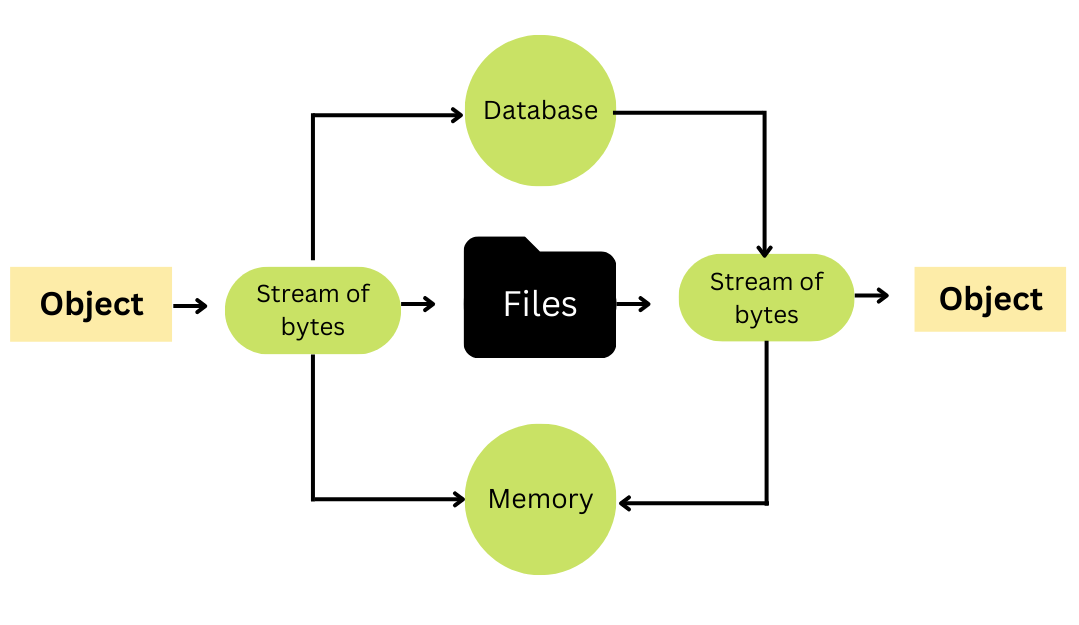
Built-in marker interfaces in Java are interfaces that are already available and ready to use within the JDK. Among the numerous built-in marker interfaces are the following:
Cloneable Interface
- Serializable Interface
- Remote Interface
Cloneable Interface: Cloneable Interface is a marker interface in the Java programming language. It is a part of the java.lang package. It is used to duplicate an item and give it a different name. A class must implement the Cloneable interface if we wish to be able to copy its objects. This is used to tell the JVM that objects of the class that have implemented the Cloneable Interface can use the clone() function of the Object class.
import java.lang.Cloneable; . class E1 implements Cloneable { int idx; String strs; public E1(int idx,String strs) { this.idx = idx; this.strs = strs; } // Overriding clone() method // by simply calling Object class // clone() method. @Override protected Object clone() throws CloneNotSupportedException { return super.clone(); } } public class Demo { public static void main(String[] args) throws CloneNotSupportedException { E1 a = new E1(20, "logicmojo"); E1 b = (E1)a.clone(); System.out.println(b.idx); System.out.println(b.strs); } }
Serializable Interface: Java's Serializable Interface is a Marker Interface, which means that it is empty because it lacks any methods, fields, constants, etc. The Java IO package contains a definition of it.
import java.io.*; class E1 implements Serializable { int idx; String strs; public E1(int idx,String strs) { this.idx = idx; this.strs = strs; } } public class Demo { public static void main(String[] args) throws IOException, ClassNotFoundException { E1 a = new E1(100,"logicmojo"); FileOutputStream fos = new FileOutputStream("abc.txt"); ObjectOutputStream oos = new ObjectOutputStream(fos); oos.writeObject(a); FileInputStream fis = new FileInputStream("abc.txt"); ObjectInputStream ois = new ObjectInputStream(fis); E1 b = (E1)ois.readObject(); System.out.println(b.idx+" "+b.strs); // closing streams oos.close(); ois.close(); } }
Remote Interface: A Java marker interface called Remote Interface is specified in the java.rmi package. It serves the purpose of remote method invocation.
Crack your next tech interview with confidence!







Facts about interface in Java
Multiple Java Interfaces can be implemented by a Java class. All of the methods declared in the interfaces must be implemented by the class.
Every abstract method declared in the interface should be overridden by the class.
An object can be messaged using the interface without worrying about the class it belongs to.
The methods in the interface must have functionality, which the class must supply.
The methods of an interface are implicitly public and abstract.
An interface cannot be instantiated.
A reference to an interface may point to its implementing classes' objects.
One or more interfaces may extend from one interface. A class can implement any number of interfaces but can only extend one other class.
It is impossible for one interface to implement another. If necessary, it must extend another interface.
Nested interfaces are interfaces that are specified within of other interfaces.
Interface variables must be initialised at declaration time. The compiler will throw an error otherwise.
Java does not allow a class to implement two interfaces with identical methods but distinct return types.
Comparator Interface in Java
It is necessary to implement the compare(Object o1, Object o2) method of the Comparator interface, which accepts two Object arguments. The method should be implemented in a way that it returns a negative integer if the first argument is smaller than the second, a zero value if they are equal, and a positive integer if the first argument is larger than the second. Generics are used by the Comparable and Comparator interfaces to perform compile-time type verification.
public class PRankComparator implements Comparator<Player> { @Override public int compare(Player fPlayer, Player secPlayer) { return Integer.compare(fPlayer.getRanking(), secPlayer.getRanking()); } }
public class PAgeComparator implements Comparator<Player> { @Override public int compare(Player fPlayer, Player secPlayer) { return Integer.compare(fPlayer.getAge(), secPlayer.getAge()); } }
PRankingComparator playerComparator = new PRankingComparator(); Collections.sort(volleyballTeam, playerComparator);
Output:
Before Sorting: [B, A, D]
After Sorting: [A, B, D]
Nested Interface
The process of declaring an interface inside of another existing interface or a class is known as interface nesting. An Inner Interface is another name for the Nested Interface.
Direct access to the Nested Interface is not possible. In order to resolve the Namespaces by grouping them with their respective Interfaces and Classes, nesting is implemented. Using this method, we can call the nested interface by using the name of the outer class or outer interface, a dot (. ), and the interface name.
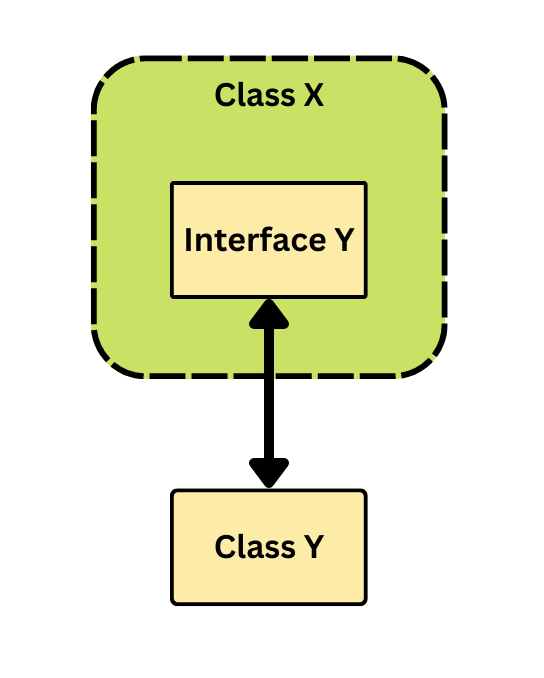
class Automobile { interface Activity { void move(); } } class Bike implements Automobile.Activity { public void move() { System.out.println("Bike is Automobile"); } } public class Tester { public static void main(String args[]) { Bike honda = new Bike(); honda.move(); } }
Advantages of Interface
We can achieve total abstraction thanks to interfaces.
An application can achieve loose coupling by using interfaces. This indicates that the implementation of the other class is unaffected by changes made to the first one.
Interfaces can be used to simplify complicated architectures and make object dependencies obvious.
Multiple inheritances can be implemented via interfaces.
Disadvantages of Interface
Since they must be made public, interfaces disclose their member variables. This could cause problems with testing and forecasting the behaviour of your code (and the same reasons why one should avoid making class member variables public).
In some circumstances, changing an interface could result in unforeseen behaviour for the classes that implement it since an interface can be thought of as a contract that is implemented by numerous classes. For instance, if a new method is added that is not the default, if the old classes do not implement that method, compilation issues will be raised. Interfaces ought to be immutable in order to prevent this as much as possible (this could be a disadvantage in certain situations, too).
One interface could contain several methods that may not all be required for a class if interfaces are not carefully developed. This could result in an empty implementation for these methods, making your code verbose. Interfaces must be properly developed with the Interface Segregation Principle in mind in order to avoid this.
Types of Interface
Functional Interface
Marker Interface
Functional Interface
An interface that just has one abstract method is said to be functional. They are only capable of displaying one functionality. Lambda expressions can be used to represent an instance of a functional interface starting with Java 8. Any number of default methods can be included in a functional interface. Some examples of useful interfaces are Comparable, Runnable, and ActionListener.
Functional interfaces don't require the use of the abstract keyword because the method defined inside the interface is abstract solely by default, making its use optional. Lambda expressions are another example of a functional interface.
Marker Interface
An interface is referred to as a Marker interface if it lacks any methods, fields, Abstract Methods, and Constants. Additionally, an interface is referred to as a marker interface if it is empty. Examples of Marker interfaces include the Serializable and Cloneable interfaces.
💡 Why can't interfaces have a constructor?
A complete abstraction of a class is an interface. By default, every data member in the interface is public, static, and final. If any static final fields are not initialised in the default constructor at the time of declaration, a compilation error will be raised and the variable variable Name will not be initialised.
Since the methods inside an interface are by default public abstract, the implementing class must be used to give the method implementation rather than the interface itself. Consequently, there is no requirement for a constructor inside the interface.
There are no non-static data members in the interface, hence there is no need for a constructor, which is needed to initialise non-static data elements.
There is no implementation of the methods that are contained in the interface, hence there is no need to create objects to call the methods, rendering the constructor in the interface redundant.
A compile-time error will be generated by the compiler if we try to add a constructor inside the interface.
New Features After JDK 8
1. The interface could not describe the implementation before JDK 8. Now that interface methods have default implementations, we can add them. This default implementation serves a specific purpose and has no bearing on interfaces' original design.
Let's say an existing interface needs a new function added to it. Since the classes have not yet added those new functions, it is obvious that the old code will not function. Therefore, we will provide a default body for the newly added functions using default implementation. the previous codes will still function.
We may now specify static methods in interfaces that can be invoked independently without an object, which is another capability that was added in JDK 8. The fact that these methods are not inheritable.
Interfaces can now contain the following starting with Java 9: Static methods, Private methods, Private Static methods
Generic Interface In Java
Generics force all (reference) types that are passed in dynamically as parameters to be taken into account by a class, interface, and method. That guarantees type safety. After the class name as of the instance variable, generic class parameters are supplied in angle brackets "<>".
The interfaces in Java that deal with abstract data types are known as generic interfaces. Java collections can be independently manipulated with the aid of interfaces, regardless of representational details. They are accustomed to creating hierarchies in Java via multiple inheritance. The Java class is not the same as them. These only have static and final variables and include all abstract methods. Not objects, but only interfaces can be referenced. These lack constructors and instance variables, in contrast to classes. The word "implements" is relevant here. These resemble generic classes in many ways.
Implementation
package java.lang; import java.util.*; public interface Comparable<T> { public int compareTo(T o); }
Interface Constant in Java
Constants may be present in a Java interface. Constant definition in an interface may make sense in some circumstances. especially if the classes that implement the interface will utilise those constants for calculations or as inputs for some of the interface's methods. But if you can, try to stay away from using variables in Java interfaces, is my suggestion to you.
Even if you omit the terms "public," "static," and "final" from the variable declaration, all variables in an interface are automatically public, static, and final.
Here is an illustration of a Java interface with two declared constants:
public interface MyInterface { int FALSE = 0; int TRUE = 1; }
Need for default methods in interfaces
Default methods are implicitly public, just like standard interface methods; the public modifier is not required.
They differ from standard interface methods in that they give an implementation and are declared with the default keyword at the start of the method signature.
public interface MyInterface { // regular interface methods default void defaultMethod() { // default method implementation } }
The inclusion of default methods in the Java 8 version makes sense.
When one or more methods are introduced to an interface in a typical abstraction-based architecture with one or more implementations, all of the implementations
are required to implement them as well. If not, the design will just fail.
Default interface methods are a practical solution to this problem. They give us the ability to extend an interface with new methods that are built-in to implementations. Consequently, there is no need to change the implementing classes. Backward compatibility is elegantly maintained in this fashion without the need to refactor the implementers.
With this article at Logicmojo, you must have the complete idea of interface in Java.Frequently Asked Questions (FAQs)
In Java, an interface is a reference type that defines a contract or a set of abstract methods that a class must implement. It serves as a blueprint for classes, specifying a set of methods that the implementing classes must adhere to. An interface acts as a pure abstract class, allowing for multiple inheritance-like behavior.
Here are the key aspects and characteristics of interfaces in Java:
1. Declaration and Syntax:
An interface is declared using the `interface` keyword, followed by the interface name. The methods within the interface are declared without an implementation, making them abstract by default. Here's the syntax for declaring an interface:
interface MyInterface {
// Method declarations (abstract methods)
}
2. Abstract Methods:
An interface consists of method declarations, which are abstract by default. Abstract methods do not have a body (implementation) and are meant to be overridden by the implementing classes. The implementing classes must provide the implementation for all the abstract methods declared in the interface.
interface MyInterface {
void method1();
int method2(String param);
}
3. Constant Fields:
In addition to abstract methods, interfaces can also define constant fields (also known as static final fields). These fields are implicitly public, static, and final, and must be initialized with a value.
interface MyInterface {
int MY_CONSTANT = 42;
}
4. Multiple Inheritance:
Java interfaces allow for multiple inheritance of type, meaning a class can implement multiple interfaces. This allows a class to inherit and implement the behavior defined by multiple interfaces. To implement multiple interfaces, separate them with commas in the `implements` clause of the class declaration.
class MyClass implements Interface1, Interface2, Interface3 {
// Class implementation
}
5. Implementation by Classes:
Interfaces act as contracts that classes must adhere to. A class that implements an interface must provide implementations for all the abstract methods declared in the interface. This is done using the `implements` keyword followed by the interface name(s) in the class declaration.
6. Polymorphism and Interface References:
Interface references can be used to refer to objects of classes that implement the interface. This allows for polymorphism, where different objects of implementing classes can be treated as instances of the interface. This provides flexibility and allows for writing more generic and reusable code.
7. Default Methods and Static Methods (Java 8+):
Starting from Java 8, interfaces can also define default methods and static methods. Default methods provide a default implementation for a method in the interface itself, allowing for backward compatibility when adding new methods to existing interfaces. Static methods in interfaces provide utility methods that can be called directly on the interface itself, without requiring an instance.
Interfaces are widely used in Java to achieve abstraction, define contracts, support multiple inheritance-like behavior, enable polymorphism, and promote code modularity and reusability. They are an essential part of object-oriented programming in Java and provide a powerful mechanism for defining and implementing common behavior across multiple classes.
Interfaces in Java serve several important purposes and offer significant benefits. Here are the key uses and advantages of interfaces:
1. Abstraction and Contract:
Interfaces provide a way to define abstract behavior and contracts that classes must adhere to. By declaring a set of methods in an interface, you define a contract that any class implementing that interface must fulfill. This allows you to express the desired functionality without specifying the implementation details.
2. Multiple Inheritance-like Behavior:
Java interfaces allow for multiple inheritance of type, enabling a class to implement multiple interfaces. This flexibility allows classes to inherit and implement behavior from multiple sources, facilitating code reuse and supporting a higher level of abstraction.
3. Polymorphism and Flexibility:
Interfaces support polymorphism, allowing objects of implementing classes to be treated as instances of the interface. This means you can write code that accepts interface references, enabling more flexible and generic programming. Polymorphism through interfaces promotes code modularity, extensibility, and loose coupling.
4. Consistent API Design:
Interfaces play a crucial role in API design, allowing developers to define a clear and consistent set of methods that external code can interact with. By adhering to an interface, classes provide a standardized API, making it easier for other developers to understand and use the provided functionality.
5. Modularity and Separation of Concerns:
Interfaces promote modular design by separating the contract or behavior definition from the implementation details. This separation allows for better code organization and the division of responsibilities between different parts of a program. Interfaces help enforce the Single Responsibility Principle and make it easier to change or extend the implementation without affecting other parts of the codebase.
6. Code Reusability:
Interfaces promote code reusability by allowing classes to implement common behavior defined by interfaces. Through interface implementation, you can reuse the same code across multiple classes without the need for inheritance hierarchies. This improves code maintainability, as changes or enhancements can be made to the interface, affecting all implementing classes simultaneously.
7. Enforce Design Contracts and Specifications:
Interfaces serve as a contract or specification for classes that implement them. By defining an interface, you set expectations for the behavior and capabilities of implementing classes. This contract helps ensure that classes adhere to a specific design and follow a predetermined set of guidelines, leading to more reliable and robust software.
8. Versioning and Backward Compatibility:
Interfaces provide a mechanism for versioning and maintaining backward compatibility. By adding new methods as default methods in interfaces (introduced in Java 8), you can add new functionality to interfaces without breaking the existing implementation of the classes that implement them. This facilitates code evolution and smooth migration of existing codebases.
In summary, interfaces in Java serve as a foundation for abstraction, contract definition, and code modularity. They enable polymorphism, support multiple inheritance-like behavior, promote code reuse, and help maintain a consistent API design. By leveraging interfaces effectively, you can write more modular, flexible, and extensible code.
The term "interface" in Java is derived from the broader concept of interfaces in software engineering. In general, an interface represents a contract or a boundary through which two entities interact. In the context of Java, the term "interface" was adopted to describe a specific construct that defines a contract for classes to adhere to.
The choice of the term "interface" in Java is rooted in its similarity to real-world scenarios where devices, systems, or components interact with each other through well-defined interfaces. Here are a few reasons why Java interface is called an interface:
1. Conceptual Representation of Interactions:
In Java, an interface is designed to capture the notion of interactions between classes and provide a way to define the contract or rules for those interactions. It represents a way for different entities (classes) to communicate and interact with each other in a structured and well-defined manner.
2. Contractual Obligations:
The term "interface" reflects the contractual nature of Java interfaces. Just as in the real world, where interfaces define the rules, protocols, or agreements between two parties, a Java interface specifies the methods that a class must implement to fulfill the contract. By implementing an interface, a class agrees to abide by the contract and provide the specified behavior.
3. Separation of Concerns:
The term "interface" also emphasizes the separation of concerns between the interface definition and its implementation. In Java, an interface separates the specification of the desired behavior (methods) from the actual implementation of that behavior in the classes that implement the interface. This separation allows for loose coupling and promotes modularity.
4. Similarity to Language Constructs in Other Paradigms:
The term "interface" in Java is consistent with the terminology used in other programming languages and software engineering paradigms. For example, in object-oriented programming, interfaces have similar characteristics and serve a similar purpose in languages like C++, C#, and Objective-C.
It's worth noting that the term "interface" has been used in various programming languages and contexts prior to Java. In Java, the concept of interfaces was influenced by previous work, including the Objective-C language's protocols and the concept of abstract data types. The Java language designers adopted the term "interface" to describe this construct in a way that aligns with its intended purpose and familiar concepts from the broader software engineering domain.
In summary, Java interfaces are called interfaces to represent the contractual nature of the construct, the separation of concerns between interface definition and implementation, and the conceptual similarity to interactions and agreements in real-world scenarios. The term "interface" is consistent with terminology used in other programming languages and reflects established practices in software engineering.
In Java, inheritance and interfaces are both mechanisms for achieving abstraction, code reuse, and polymorphism, but they serve different purposes and have distinct characteristics. Let's explore the differences between inheritance and interfaces in detail:
Inheritance:
1. Purpose: Inheritance establishes an "is-a" relationship between classes, allowing a derived class (subclass) to inherit properties and behaviors from a base class (superclass).
2. Relationship: Inheritance represents an "is-a" relationship, where a derived class is a specialized version of the base class. The derived class inherits the members (fields and methods) of the base class.
3. Mechanism: Inheritance is implemented using the `extends` keyword, where the derived class extends the base class. The derived class inherits the non-private members of the base class.
4. Code Reuse: Inheritance promotes code reuse by allowing derived classes to inherit the common behavior and characteristics of the base class. The derived class can add additional features or override inherited members to provide specialized behavior.
5. Single Inheritance: Java supports single inheritance, meaning a class can have only one direct superclass. However, it can inherit indirectly from multiple classes through an inheritance hierarchy.
6. Access to Members: Derived classes have access to public and protected members of the base class. Private members are not accessible directly in the derived class but can be accessed through public or protected methods defined in the base class.
7. Inheriting Implementation: Inheritance involves inheriting the implementation details of the base class. The derived class can reuse and build upon the existing implementation, potentially reducing code duplication.
8. Tighter Coupling: Inheritance establishes a strong relationship between classes, resulting in tighter coupling. Changes made to the base class can affect the derived class, and vice versa.
Interface:
1. Purpose: An interface defines a contract or a set of abstract methods that a class must implement. It represents a common behavior or capability that can be shared among unrelated classes.
2. Relationship: Interfaces represent a "can-do" relationship, where a class can declare that it can perform certain behaviors specified by an interface. The class is not required to be related to the interface through inheritance.
3. Mechanism: Interfaces are implemented using the `implements` keyword. A class can implement one or more interfaces, providing the implementation for the methods declared in those interfaces.
4. Code Reuse: Interfaces promote code reuse by allowing unrelated classes to share a common behavior defined by the interface. Implementing multiple interfaces enables a class to exhibit multiple behaviors from different interfaces.
5. Multiple Implementation: Java supports multiple interface implementation, allowing a class to implement multiple interfaces simultaneously. This enables a class to provide the behavior specified by multiple contracts.
6. Access to Members: Interfaces do not define instance variables or implement method bodies. They only declare abstract methods and constant fields. Implementing classes must provide the implementation for all the methods declared in the interface.
7. Decoupling: Interfaces promote loose coupling between classes, as they define a contract without specifying the implementation details. Implementing classes are free to provide their own implementation, independent of the class hierarchy.
8. API Design: Interfaces play a crucial role in API design by providing a standardized way for classes to interact. Interfaces define a contract that external code can rely on, facilitating code integration and interoperability.
In summary, inheritance establishes a hierarchical relationship between classes, allowing for code reuse and specialization, while interfaces define contracts that unrelated classes can fulfill, promoting loose coupling and polymorphism. Inheritance involves inheriting implementation details, while interfaces focus on specifying behavior without providing the implementation. Both inheritance and interfaces are powerful tools in Java, serving different purposes in achieving abstraction, code reuse, and polymorphism.
In Java, there are different types of interfaces based on their characteristics and intended use. Let's explore the various types of interfaces in detail:
1. Normal Interfaces:
Normal interfaces are the most commonly used type of interface in Java. They define a set of abstract methods that classes must implement. Normal interfaces do not have any implementation details and only declare method signatures and constant fields.
2. Marker Interfaces:
Marker interfaces, also known as tagging interfaces, are interfaces with no declared methods. They serve as markers or flags that provide information to the compiler or runtime environment about a class. Implementing a marker interface indicates that a class has certain properties or capabilities.
Examples of marker interfaces in Java include `Serializable`, which signifies that an object can be serialized, and `Cloneable`, which indicates that an object can be cloned.
3. Functional Interfaces:
Functional interfaces, introduced in Java 8, are interfaces that have a single abstract method. They are used in functional programming and enable the use of lambda expressions and method references. Functional interfaces often represent actions, predicates, or functions that can be expressed concisely.
The `java.util.function` package contains many pre-defined functional interfaces, such as `Predicate`, `Consumer`, `Function`, and `Supplier`.
4. SAM Interfaces:
SAM (Single Abstract Method) interfaces are a special type of functional interface that have exactly one abstract method. SAM interfaces are used when working with lambda expressions and represent a single operation or behavior.
SAM interfaces can be annotated with the `@FunctionalInterface` annotation to ensure that they have only one abstract method. This annotation is optional but provides compile-time checks and documentation.
5. Default Method Interfaces:
Starting from Java 8, interfaces can have default methods. Default methods provide a default implementation for a method within the interface itself. They allow interfaces to evolve and add new methods without breaking backward compatibility for implementing classes.
Default methods are defined using the `default` keyword and can be overridden by implementing classes if desired.
6. Static Method Interfaces:
Also introduced in Java 8, interfaces can have static methods. Static methods in interfaces provide utility methods that can be called directly on the interface itself, without requiring an instance of the implementing class.
Static methods in interfaces are defined using the `static` keyword and are not inherited or overridden by implementing classes.
These are the main types of interfaces in Java, each with its own purpose and characteristics. Understanding these different types of interfaces allows you to leverage their specific features and apply them appropriately in your Java programs.
Interfaces in Java provide several benefits, which contribute to the design, flexibility, and maintainability of code. Here are the key advantages of using interfaces:
1. Abstraction and Separation of Concerns:
Interfaces promote abstraction by defining a contract or set of methods that a class must implement. They allow you to focus on what needs to be done (the behavior) rather than how it is implemented. This separation of concerns improves code organization and makes it easier to understand, modify, and maintain.
2. Code Reusability and Polymorphism:
Interfaces enable code reusability by allowing multiple classes to implement the same interface. By implementing an interface, classes can share common behavior without the need for an inheritance hierarchy. This promotes modular design and facilitates the creation of interchangeable components.
Additionally, interfaces support polymorphism, allowing objects of implementing classes to be treated as instances of the interface. This flexibility promotes loose coupling, enhances code extensibility, and simplifies code changes and enhancements.
3. Multiple Inheritance-like Behavior:
Java interfaces allow a class to implement multiple interfaces, providing a form of multiple inheritance-like behavior. This allows classes to inherit and exhibit multiple behaviors from different interfaces. It overcomes the limitations of single inheritance and allows for more flexible and modular code design.
4. API Design and Standardization:
Interfaces play a crucial role in API design by providing a clear and standardized way for classes to interact. By adhering to an interface, classes provide a common set of methods that external code can rely on. This standardization promotes code integration, improves interoperability, and simplifies collaboration among developers.
5. Future Compatibility and Extensibility:
Interfaces provide a way to define contracts and specifications. By programming to interfaces, you can write code that is less dependent on specific implementations. This makes it easier to replace or extend the implementation of a class without affecting other parts of the codebase, promoting future compatibility and maintainability.
6. Unit Testing and Mocking:
Interfaces facilitate unit testing and mocking by allowing you to create mock implementations of interfaces for testing purposes. By providing test implementations of interfaces, you can isolate units of code for testing, simulate behavior, and verify interactions with external components.
7. Dynamic Binding and Runtime Flexibility:
Interfaces support dynamic binding, where the appropriate implementation is determined at runtime based on the object's actual type. This allows for greater flexibility and adaptability, as different implementations can be used interchangeably based on the context or runtime conditions.
8. Encapsulation and Information Hiding:
Interfaces promote encapsulation by focusing on the contract and public-facing behavior rather than the internal implementation details. By programming to interfaces, you hide the implementation details and expose only the necessary public methods, improving the clarity and maintainability of the code.
In summary, interfaces in Java offer significant benefits such as abstraction, code reusability, polymorphism, multiple inheritance-like behavior, API design, future compatibility, unit testing support, dynamic binding, encapsulation, and information hiding. By leveraging interfaces effectively, you can create modular, flexible, and maintainable code that is easier to understand, extend, and collaborate on.
In Java, both abstract classes and interfaces provide mechanisms for achieving abstraction and defining contracts. However, there are fundamental differences between the two. Let's explore the differences between abstract classes and interfaces in detail:
Abstract Classes:
1. Definition and Purpose:
An abstract class is a class that cannot be instantiated and is intended to be subclassed. It serves as a partially implemented blueprint for creating derived classes.
2. Keyword and Syntax:
Abstract classes are declared using the `abstract` keyword, and they can have abstract and non-abstract methods. Abstract methods are declared without an implementation, while non-abstract methods provide concrete implementations.
3. Inheritance:
Abstract classes can be extended by other classes using the `extends` keyword. Subclasses are required to provide implementations for all abstract methods inherited from the abstract class.
4. Single Inheritance:
Java supports single inheritance, meaning a class can extend only one abstract class (or any other class). An abstract class can serve as a superclass for multiple derived classes.
5. Constructors:
Abstract classes can have constructors, which are used for initializing the abstract class or its members. Constructors are invoked when creating instances of derived classes.
6. Access Modifiers:
Abstract classes can have different access modifiers for their members, allowing control over the visibility and accessibility of the members to derived classes and other code.
7. State and Behavior:
Abstract classes can contain instance variables (state) and method implementations (behavior). They can provide common functionality to derived classes by implementing non-abstract methods.
8. Code Reuse:
Abstract classes promote code reuse by providing a common implementation and behavior for derived classes. Derived classes can inherit and extend the abstract class, inheriting its state and behavior.
Interfaces:
1. Definition and Purpose:
An interface is a reference type that defines a contract or a set of abstract methods that a class must implement. It represents a pure abstraction of behavior without any implementation details.
2. Keyword and Syntax:
Interfaces are declared using the `interface` keyword. They can only have abstract methods (implicitly) and constant fields. Interfaces do not contain any implemented methods.
3. Implementation:
Classes implement interfaces using the `implements` keyword. Implementing a interface means providing the implementation for all the abstract methods declared in the interface.
4. Multiple Inheritance-like Behavior:
Java interfaces allow a class to implement multiple interfaces, enabling a form of multiple inheritance-like behavior. This allows classes to exhibit multiple behaviors from different interfaces.
5. Polymorphism and Flexibility:
Interfaces support polymorphism, allowing objects of implementing classes to be treated as instances of the interface. This promotes loose coupling and enhances flexibility and extensibility.
6. API Design:
Interfaces play a crucial role in API design, providing a standardized way for classes to interact. By adhering to an interface, classes provide a common set of methods that external code can rely on.
7. Contract and Behavior Specification:
Interfaces specify a contract that classes must adhere to, defining the behavior that implementing classes must provide. Interfaces focus solely on the method declarations and do not contain implementation details.
8. Code Reusability:
Interfaces promote code reusability by allowing unrelated classes to share a common behavior defined by the interface. Implementing multiple interfaces enables a class to exhibit multiple behaviors.
In summary, abstract classes and interfaces in Java serve different purposes. Abstract classes provide a partially implemented blueprint for creating derived classes and promote code reuse. They are used for inheritance and allow for the sharing of state and behavior. Interfaces, on the other hand, define contracts and specify behavior. They enable multiple inheritance-like behavior and focus on achieving loose coupling and code reuse through polymorphism. The choice between abstract classes and interfaces depends on the specific requirements of the design and the intended usage of the class or component.
In Java, interfaces cannot be extended using the `extends` keyword as classes are extended. Instead, interfaces can only be implemented by classes using the `implements` keyword. This is a key distinction between interfaces and classes in Java.
When a class implements an interface, it agrees to fulfill the contract defined by the interface by providing implementations for all the abstract methods declared in the interface. By implementing an interface, the class declares that it can perform certain behaviors specified by the interface.
Here's an example that demonstrates the implementation of an interface in Java:
interface MyInterface {
void method1();
int method2();
}
class MyClass implements MyInterface {
public void method1() {
// Implementation of method1
}
public int method2() {
// Implementation of method2
return 0;
}
}
In the example above, the `MyInterface` interface declares two abstract methods: `method1` and `method2`. The `MyClass` class implements the `MyInterface` interface using the `implements` keyword. It provides the required implementation for both methods.
Implementing an interface is a way to achieve abstraction and fulfill a contract. The class that implements the interface is required to provide the behavior specified by the interface, making the class eligible for treating objects of that class as instances of the interface.
It's important to note that a class can implement multiple interfaces by separating them with commas in the `implements` clause. This allows the class to exhibit behavior specified by multiple interfaces simultaneously.
In summary, in Java, interfaces are implemented by classes using the `implements` keyword. Classes provide the implementation for the abstract methods declared in the interface, fulfilling the contract specified by the interface. Interfaces cannot be extended using the `extends` keyword like classes can, but a class can implement multiple interfaces to exhibit multiple behaviors.
Interfaces in Java provide a powerful mechanism for achieving abstraction, promoting code reuse, and defining contracts. Here are some situations where using interfaces is beneficial:
1. Defining Behavior and Contracts:
Use interfaces when you want to define a contract or a set of methods that classes must adhere to. Interfaces allow you to express the expected behavior without specifying the implementation details. By programming to interfaces, you establish clear guidelines for classes and provide a standardized way for them to interact.
2. Enforcing Polymorphism:
Use interfaces when you want to enable polymorphism, allowing objects of different classes to be treated as instances of a common interface. This promotes flexibility and extensibility in your code. By programming to interfaces, you can write more generic code that works with different implementations.
3. Promoting Code Reusability:
Use interfaces to promote code reusability by providing a common behavior that can be implemented by multiple classes. By defining an interface, you can create a contract that specifies a set of methods that implementing classes must provide. This allows unrelated classes to share the same behavior without the need for an inheritance hierarchy.
4. Supporting Multiple Inheritance-like Behavior:
Use interfaces when you need to support multiple inheritance-like behavior. Java allows a class to implement multiple interfaces, enabling it to exhibit behavior from different sources. This flexibility is especially useful when you want a class to inherit and exhibit behaviors from unrelated classes.
5. API Design and Interoperability:
Use interfaces when designing APIs to provide a clear and standardized way for classes to interact with external code. By defining interfaces, you establish a well-defined contract that external code can rely on. This simplifies integration, enhances interoperability, and allows for easier collaboration among developers.
6. Unit Testing and Mocking:
Use interfaces to facilitate unit testing by creating mock implementations of interfaces. Interfaces allow you to isolate units of code for testing purposes and verify interactions with external components. Mock implementations of interfaces can be created to simulate behavior and facilitate unit testing.
7. Future Compatibility and Extensibility:
Use interfaces to provide future compatibility and extensibility. By programming to interfaces, you reduce dependencies on specific implementations and make it easier to replace or extend the implementation without affecting other parts of the codebase. Interfaces allow for smoother evolution of the code as requirements change or new functionalities are added.
8. Decoupling and Dependency Inversion:
Use interfaces to promote decoupling and dependency inversion. By depending on interfaces rather than concrete implementations, you can reduce coupling between components and achieve greater flexibility. This allows for easier substitution of implementations and promotes modular design.
In summary, interfaces in Java are valuable when you want to define contracts, enforce behavior, promote code reusability, support polymorphism and multiple inheritance-like behavior, design APIs, facilitate unit testing, ensure future compatibility, and achieve decoupling and dependency inversion. By leveraging interfaces effectively, you can create modular, flexible, and maintainable code that is easier to understand, extend, and collaborate on.
While interfaces in Java offer numerous benefits, they also come with certain disadvantages and considerations. Here are some of the disadvantages of interfaces in Java:
1. Limited Flexibility in Implementation:
Interfaces in Java only allow for abstract method declarations and constant fields. They do not allow the inclusion of concrete method implementations or instance variables. This can be a limitation when you want to provide a default behavior or include shared state among implementing classes.
2. Implementation Overhead:
Implementing an interface requires providing implementations for all the abstract methods declared in the interface. This can result in additional coding effort, especially when implementing complex interfaces with numerous methods. It requires careful consideration and proper implementation of each method to fulfill the interface contract.
3. Interface Proliferation:
In large-scale projects or complex systems, the use of interfaces can lead to a proliferation of interfaces. As the number of interfaces increases, it can become challenging to manage and maintain the relationships between interfaces and implementing classes. This can lead to increased complexity and reduced code readability.
4. Tighter Coupling in Some Cases:
While interfaces generally promote loose coupling, there can be scenarios where implementing classes become tightly coupled with specific interfaces. This occurs when the implementing class relies heavily on the methods declared in the interface and cannot easily be decoupled from it. This tight coupling can limit flexibility and hinder future changes.
5. Limited Versioning Support:
Modifying an existing interface can have implications for implementing classes. If you make changes to an interface by adding or modifying methods, implementing classes need to be updated to provide implementations for the new or modified methods. This can cause compatibility issues and require careful management during versioning.
6. Inheritance vs. Interface Implementation Conflict:
When a class implements an interface, it cannot simultaneously inherit from another class. This can be a limitation when you want to reuse code from an existing class hierarchy while also implementing an interface. In such cases, the choice between inheritance and interface implementation needs to be carefully considered.
7. Difficulty in Handling Existing Code:
Introducing interfaces into an existing codebase can require significant refactoring efforts. If the codebase relies heavily on concrete classes, introducing interfaces can necessitate modifications to a large portion of the code to implement the interface contract. This can be time-consuming and introduce the risk of introducing bugs.
8. Learning Curve and Complexity:
Understanding and effectively utilizing interfaces may require additional learning and experience, particularly for developers new to Java or object-oriented programming. The concepts of abstraction, contracts, and polymorphism associated with interfaces can introduce complexity and require a solid understanding of programming principles.
Despite these disadvantages, interfaces remain a valuable and widely used feature in Java. By understanding their limitations and making informed design decisions, interfaces can be effectively employed to promote abstraction, code reuse, polymorphism, and modularity in Java applications.
